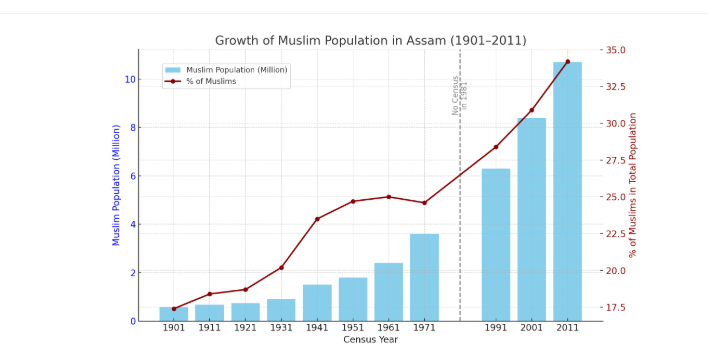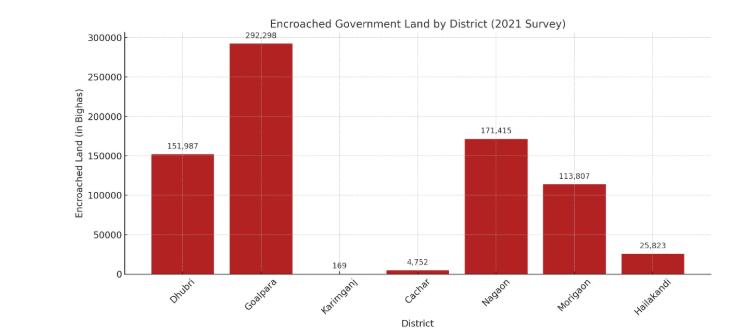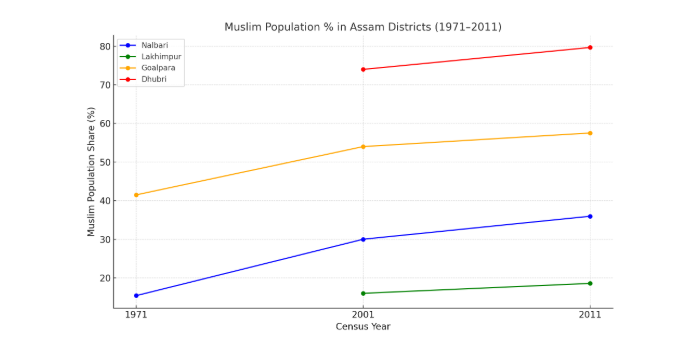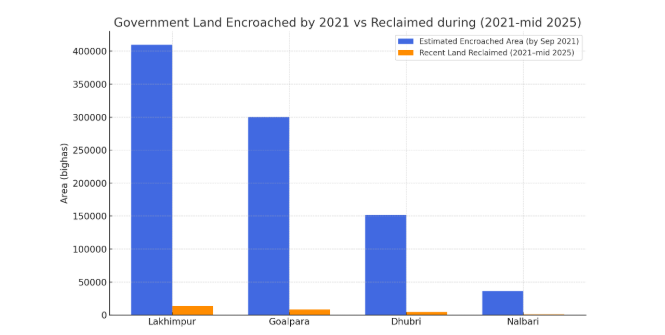Assam’s Last Stand: A Struggle against Demographic Warfare to Reclaim Encroached Ancestral Lands
- In Current Affairs
- 04:17 PM, Jul 21, 2025
- Ankita Dutta and Vladimir Adityanath
The incident of illegal Bangladeshi immigrants and land-grabbers firing at Assam Police personnel during the eviction drive at Dholpur-Gorukhuti village under Sipajhar revenue circle in Darrang district’s Mangaldoi Lok Sabha constituency in 2021 is now repeating itself again in different places of Assam. The recent eviction of more than a thousand families from at least 3,500 bighas of land in Charuwa Bakra, Chirakuta, and Santoshpur villages in Dhubri district saw resistance from the local Muslims, who not only damaged excavators but also attacked Police personnel, thereby prompting the latter to resort to baton charges to control the situation.
This is nothing but yet another dreadful manifestation of a problem that has been plaguing Assam since the pre-Independence era, when Lord Curzon had clubbed Assam with Eastern Bengal to create a new province in 1905. Although that decision was revoked in 1911 after six years of nationalist agitation under the leadership of Bipin Chandra Pal, the floodgates for illegal immigrants have remained open for more than a century now.
It is a part of the larger conspiracy of making Assam an Islamic state, oft-quoted as the policy of Lebensraum by several Bangladeshi academics and political leaders on numerous occasions. Author Shiva Prasad Roy describes this eight-decade-long demographic warfare against Assam in his book Binajuddhe Bharat Dokhol (“Conquering India Without Overt Military Action”) [1]. He concludes that such a strategy is possible because of –
- Continuous financial and intellectual support from foreign nations with vested interests like the USA.
- Academic, legal and moral support from self-proclaimed “intellectuals”, journalists, writers, public speakers, lawyers and human rights activists residing within Bharat, working in coordination to achieve their pre-determined goals.
This lobby is always at the forefront of accusing the common Assamese people of xenophobia, repeatedly claiming that “one particular religious community” (Muslims) is being targeted in the name of protecting the Assamese culture and identity. They simply refuse to acknowledge the bitter reality of Assam’s slow and silent demographic invasion by hordes of land-hungry Muslims dating back to the colonial period. Neither do they acknowledge the national security threat of allowing a strategic, foreign-funded campaign of demographic invasion to go on in a state known as the “Gateway to the North-East”.
Illegal immigration in Assam is a serious national security, economic and demographic issue and not a communal one. It is more a matter of saving the culture, customs, language and rituals of the 40-plus indigenous communities of Assam than a so-called “local Hindu-Muslim issue” [2].

We can observe an uninterrupted and steep growth in the percentage of Muslim population in Assam since 1941 [3], having jumped from 30.9% to 34.2% during 2001-2011. A Report on ‘Illegal Migration into Assam’ by the then Governor of Assam, Lt. Gen (Retd.) S.K. Sinha in 1998 showed that the Muslim population of Assam rose by 77.42% between 1971 and 1991. The Hindu population had risen by a mere 41.89% during the same period. The bordering districts of Dhubri, Goalpara, Sribhumi (formerly Karimganj), Cachar, Hailakandi, besides Nagaon and Morigaon, have been the worst-affected. Large-scale encroachments upon Government, Reserved Forest and other Protected lands have been extensively documented during the State Government Survey of 2021.

Genesis of the Problem
Although Assam has always been a land enriched by successive waves of migration and migrants, the peculiarity of the migration problem predominantly began in the late 19th century. It was around this time that the Assamese had started employing cheap labour from the surrounding regions, especially Bengal (now Bangladesh), to work in their farms and agricultural fields. The discovery of tea in Assam resulted in the migration of different indigenous communities from the Chhotanagpur plateau region to work as labourers in the large British-owned tea estates. Gradually, migrants seeking job prospects in the Northeastern oil fields were naturally drawn to the region. The British also encouraged Bengali Muslim peasants from present-day Bangladesh to settle in different regions of Assam for agricultural activities.
During Sadullah’s Muslim League Ministry (1937-46), a concerted effort was being made to encourage large-scale migration of Bangladeshi Muslims into Assam to create a large political vote-bank. Very conveniently, the immigration-favouring nexus of academicians and media houses often glosses over these historical facts, thereby putting the entire blame on the indigenous people of Assam, classified under a vague umbrella term of ‘Assamese nationalists’. After the Partition of 1947, the porous nature of the India-Bangladesh border allowed unabated migration for the next several decades. Assam saw two big waves of refugee influx between the years 1947-1971. While the Muslim migrants from East Pakistan were mostly landless economic refugees, a continuous stream of persecuted Bengali-speaking minority Hindus from Sylhet were also coming and settling down in the adjoining areas of the Barak Valley.
The real problem of encroachment of Government lands in Assam started assuming serious proportions by 1971. By now, a deep sense of insecurity had already engulfed the minds of the common public about the alarming demographic change as a result of the large-scale influx of Bengali-speaking migrants. The issue of immigration has been a deeply complex and sensitive one in the politics of Assam. It eventually culminated in the historic Assam Movement in 1979.
Land – The Invaluable Possession
The H.S. Brahma Committee for the Protection of Land Rights of Indigenous People that was constituted by the Sarbananda Sonowal Government in 2016, had submitted a detailed Report to the Government on the problem of land encroachment in Assam. As per the Report, 63 lakh bighas of Government land was estimated to be under illegal occupation, an area twice the size of Goa! The Report further pointed out that all lands in the riverine (char) areas of Assam have been occupied by a well-established institution known as Matabbar or Dewani, mostly consisting of local landlords. The modus operandi of the Matabbar is to use the immigrants as a medium for grabbing the lands of the native residents through any means, fair or foul.
In many instances, the immigrants also try to legally possess cultivable land. For all practical purposes, the Matabbar has been playing the role of the Government, doling out and making allotments of land. These local landlords have tremendous political and financial clout, which dissuades others from raising a voice against them.
Over the years, ignorance and absence of Governmental control over the vast stretches of char lands along the Brahmaputra near the India-Bangladesh border provided a fertile ground for illegal immigrants, criminals and cadres of Bangladeshi terrorist organisations like the Ansarullah Bangla Team (ABT). It is said that illegal immigrants easily find shelter in the char lands before moving into the heartland of Assam and occupying Government properties like forests and Village Grazing Reserves (VGRs). The process of completely evicting the illegal infiltrators from these lands is a tenuous one, for they are mostly settled in
- Government lands; or
- Lands procured through land mafias who force the owners to sell their plots at throwaway prices.
Land is indeed the most valuable and prized possession for the infiltrators, and it has been noticed that they are even ready to kill anyone to protect their illegally occupied lands. Several episodes in the socio-political history of Assam are proof enough of the fact that these encroachers are not the ones who would give up their landholdings so easily. The brutal attacks unleashed on the Police forces by protesters using sharp weapons, stones, machetes, and pointed bamboo sticks during the recent evictions in Dhubri and Goalpara are cases in point. They first pelted stones at our security personnel and later began attacking them, leading to chaos and law-and-order disturbance.
Eviction Drives Carried out during July 2025 (till 17th July)
Eviction drives have been carried out in the districts of Dhubri, Nalbari, Goalpara, and Lakhimpur during this period.

From the above table, a drastic increase in the population of Muslims can be observed in three of the four districts mentioned above. State Government records indicate that 8,98,073 bighas of Government land were illegally encroached in 2021, and only 27,373 bighas of illegally encroached Government land have been recovered till June 2025. Therefore, the eviction drives of July 2025 were not only necessary but also highlighted the need for many more such actions to recover illegally occupied public land.

A brief Timeline of the Eviction Drives carried out –
July 1, 2025 – Nalbari District
- Conducted in Bakrikuchi village (Borkhetri Revenue Circle, Nalbari).
- 82 bighas of Village Grazing Reserve (VGR) land reclaimed.
- Approximately 300 families affected.
- Around 12 bulldozers employed.
- Carried out peacefully in the presence of security personnel [4].
July 3, 2025 – Lakhimpur District
- Carried out to reclaim multiple VGR sites in Debera Doloni, Siringsuk, Dhakuakhana, and Raang Chali regions of North Lakhimpur.
- 235 bighas reclaimed.
- Legal notice sent to all the affected 220 families on June 29th [5].
July 8, 2025 – Dhubri District (Chapar Revenue Circle)
- Carried out to clear 3,000 bighas of illegally-occupied land in the Charuwa Bakra, Chirakuta, and Santoshpur villages.
- An estimated 1,200–1,400 families affected.
- The illegal settlers resorted to violence, pelting stones at security personnel and damaging an excavator [6].
July 8, 2025 – Dhubri District (Additional Areas)
- Conducted to reclaim over 3,500 bighas of occupied land in the Santoshpur, Charuwabakhra, Chirakuta, and Tilapara regions of Dhubri.
- Approximately 1,100 families affected.
- Led to heightened tensions and confrontations between security personnel and the illegal settlers.
July 10, 2025 – Goalpara District (Paikan Reserve Forest)
- Planned to reclaim 1,040 bighas of encroached forest land in the Krishnai Forest Range of Paikan Reserve Forest (areas like Bidyapara, Betbari).
- Notices issued to the illegal settlers first in Nov–Dec, 2024 and then again in June, 2025
- 1,040 families affected and 2,700 illegal structures demolished.
- Led to tensions and minor confrontations [7].
July 17, 2025 – Goalpara District (Paikan Violence Incident)
- On-duty security personnel were attacked by a huge mob of illegal settlers with slogans of Nara E Takbeer, Allah Hu Akbar.
- 21 Policemen injured.
- Security personnel were forced to fire a few rounds to restore law and order, resulting in the death of one illegal settler [8].
Several groups with vested interests have attempted to portray the chaos of 17th July as an example of “police brutality”. Violence against security personnel cannot be tolerated under any situation. Large parts of districts like Dhubri and Goalpara have become safe havens for extremists, organised criminal gangs and organisations with vested interests, who instigate the encroachers. The security forces are often left with no other choice but to resort to firing in self-defence. If we recall, during the Gorukhuti eviction drive in 2021, certain shocking revelations had later come to light that pointed fingers at the role of the Popular Front of India (PFI) behind instigating the encroachers to fire at the Police.
Groups like Harkat-ul-Jihad-al-Islami (HuJI-B), Jamaat-ul-Mujahideen Bangladesh (JMB), and Ansarullah Bangla Team (ABT) have exploited porous borders, the presence of a large population of illegal Bangladeshi immigrants, and religious networks to establish sleeper cells in districts such as Goalpara and Dhubri. These operatives often pose as madrasa teachers or daily-wage workers to avoid detection [9]. HuJI and JMB members have been caught attempting to recruit cadres and radicalise local youth [10]. Notably, the 2014 Burdwan blast accused were traced back to madrassas in Goalpara. The unchecked settlement of illegal immigrants in these regions poses a serious national security threat.
Assam is not only fighting against the encroachers but also against their patronisers, occupying top posts in politics, bureaucracy, academia, think-tanks, etc. It is the latter who are adept at the art of crafting a narrative of Muslim victimhood every time an eviction takes place. The recent incidents are but a small glimpse of the growing political and financial clout of the infiltrators/encroachers. Land is their primary target and will continue to remain so.
The Way Forward
Carrying out eviction drives in illegally occupied areas of any state is a legitimate right and duty of any Government. These actions should have been undertaken much earlier in a state like Assam. Nevertheless, such drives have to be a continuous process from now onwards, in the larger interest of freeing the local people’s lands and Government lands from the occupation of illegal Bangladeshis. In a welcome development, the Government of Assam has recently started a survey of the char areas of the state with the objective of ascertaining the number of people living there.
It may be mentioned here that the Justice Biplab Sarma Committee formed by the Central Government for recommending measures for the implementation of Clause 6 of the Assam Accord had also suggested a detailed survey of the chars. However, only mapping the chars would not serve the desired purpose, because accessing all details of the people living there would be another major challenge. Some chars are of permanent nature, while some appear only during the winter season, remaining submerged during the monsoons. After every monsoon, new chars appear on many tributaries of the Brahmaputra. The Government does not yet have an exact map of these chars and details of the people living there. We sincerely hope that the ongoing survey will bring out these and many other details.
To make Assam agriculturally self-sufficient and also provide employment opportunities to the local youth, it is very important that the Government effectively utilises all the evicted lands, including the chars, for farming. It might certainly not be possible to cultivate thousands of bighas of land simultaneously across the state. Hence, implementation of small-scale agricultural projects of 50-100 bighas on the lines of Gorukhuti in Darrang district and Kanyaka Multipurpose Farm in Jamugurihat of Sonitpur district will provide adequate opportunities for the Assamese youth to become self-dependent while contributing to the state’s economic output. But, our youth will have to hang on despite all the difficulties, including the annual monsoon floods. Even a short vacation of the site by our people will again see re-occupation of all the evicted lands by the encroachers. It would require consistency and patience on the part of our youth, who are often blamed for being a lazy lot as compared to the extremely hard-working Muslim migrants.
At the same time, the anti-foreigner narrative should not be reduced to a mere political gimmick in which political parties of all shades can reap their maximum advantage. This, therefore, brings us to one of the most important questions: What can be a permanent and long-term solution to the problem of land encroachment by infiltrators in Assam? What needs to be accepted here is that over the years, the problem of encroachment of Government lands in several areas of Assam never fell in the Government’s priority list.
A thorough survey of the indigenous people in districts like Dhubri, Barpeta, Goalpara, South Salmara-Mankachar, Nagaon, etc., who became landless due to Islamic demographic invasion was never conducted. This only kept adding to an already expanding problem, since it left enough scope for the encroachers to claim that they are erosion-hit people. Generally, it has been seen that the people who encroach upon Government lands quite often claim that they were erosion-affected or their farm lands were destroyed due to siltation after the annual floods. In such cases, the administration can always check their details and then cross-check them with the Revenue Officials of the respective places from where they initially came. But, this is normally not done as not many people are ready to take such pains to go through the rigorous bureaucratic process. It is precisely for this reason that even persons who have land elsewhere, say in Dhubri district, have managed to illegally grab Government land somewhere else, say in Golaghat or Jorhat, claiming themselves to be landless.
Over the years, the district administration and forest officers, under whose jurisdiction the encroachments took place, preferred to look the other way when the encroachments began initially. Later, it became extremely difficult to evict the encroachers. As per our studies conducted on the subject in different parts of Assam from 2014-2017, respondents made shocking revelations of how the Assam State Electricity Board (now Assam Power Distribution Company Limited) has been responsible for handing over power connections to the encroachers of Government lands in complete violation of the rules.
Several hill areas surrounding the city of Guwahati have also been encroached upon. Large-scale encroachment of these hills around Guwahati began only after the shifting of Assam’s capital from Shillong to Dispur. At that time, there was no housing project for Class III and Class IV employees. The prices of land skyrocketed in the city after the shifting of the capital. Hence, they preferred to grab land on the hills, facilitated by a politically influential network of land mafias and criminals. Gradually, people who flocked to the city in search of menial jobs grabbed as much land as they could. The process continued in full steam as the Government never bothered to take a serious note of it. Another interesting aspect is that most of the encroachers of the hills around Guwahati are not landless people since they already own land elsewhere in the state.
In this context, the need of the hour is a detailed study of the real, ground-level situation of the extent of encroachment so that eviction drives that are to be undertaken shortly are focused on all those of dubious nationality, surviving on encroached lands. Compiling data for such a detailed study definitely cannot be completed overnight. It will require time and diligence on the part of those entrusted with the task.
One of the possible solutions can be the State Government carrying out a thorough survey of all the landless people in the state and then allotting small plots to them. After this is done, there must be strict vigilance and no one should be allowed to encroach upon Government lands. Also, the citizenship of the evicted people must be thoroughly checked, re-checked and cross-verified before allotting them land elsewhere. It would require extensive cooperation at all levels from the common citizens, so that all lands can be freed from the clutches of infiltrators. We have immense hope from schemes such as Mission Basundhara launched by the Government of Assam.
Although the core conflict is between the native-migrant identities, it is equally important to address the civilisational conflict between Hindus and Muslims at the societal level. Assam is at a state of war against illegal immigrants. But this is not a class war. Neither is it a war cry sounded by the so-called Assamese middle class elite, as many Western progressivists, political theorists, and academics would like to depict or make us believe. The reality is that we are in the midst of a dangerous cultural and civilisational war.
We, the Assamese, are not suffering from any mania of persecuting foreigners. We have always welcomed foreigners to our land. But, we can no longer tolerate illegal aliens. All we seek to protect is our identity at all costs. And that is natural. Every individual endeavours to preserve and promote his/her own identity and culture. This basic behavioural instinct of self-preservation is magnified whenever a particular race or ethnic group encounters the threat of being politically, economically, and culturally extinct in their own homeland. The pressing need for socio-economic security can be ignored only at one’s peril.
References
- https://archive.org/details/anuprabesh-binajuddhe-bharat-dokhol/page/n13/mode/2up?utm_source=chatgpt.com
- Records from the State and Central Government
- Census Data of India 1941-2011
- https://www.sentinelassam.com/north-east-india-news/assam-news/assam-government-eviction-drive-conducted-in-nalbari-82-bighas-cleared?utm_source=chatgpt.com
- https://www.theweek.in/wire-updates/national/2025/07/03/cal19-as-eviction.html?utm_source=chatgpt.com
- https://economictimes.indiatimes.com/news/politics-and-nation/assam-eviction-drive-turns-violent-in-dhubri-cm-vows-to-clear-all-encroachments/articleshow/122347384.cms?utm_source=chatgpt.com
- https://www.indiatoday.in/india/story/encroached-forest-land-hectares-cleared-assam-goalpara-eviction-drive-2754842-2025-07-12?utm_source=chatgpt.com
- https://economictimes.indiatimes.com/news/india/two-killed-in-police-firing-as-assam-eviction-drive-turns-violent/articleshow/122650406.cms?utm_source=chatgpt.com
- https://www.nenow.in/north-east-news/assam/assam-another-suspected-jihadi-held-in-dhubri.html?utm_source=chatgpt.com







Comments